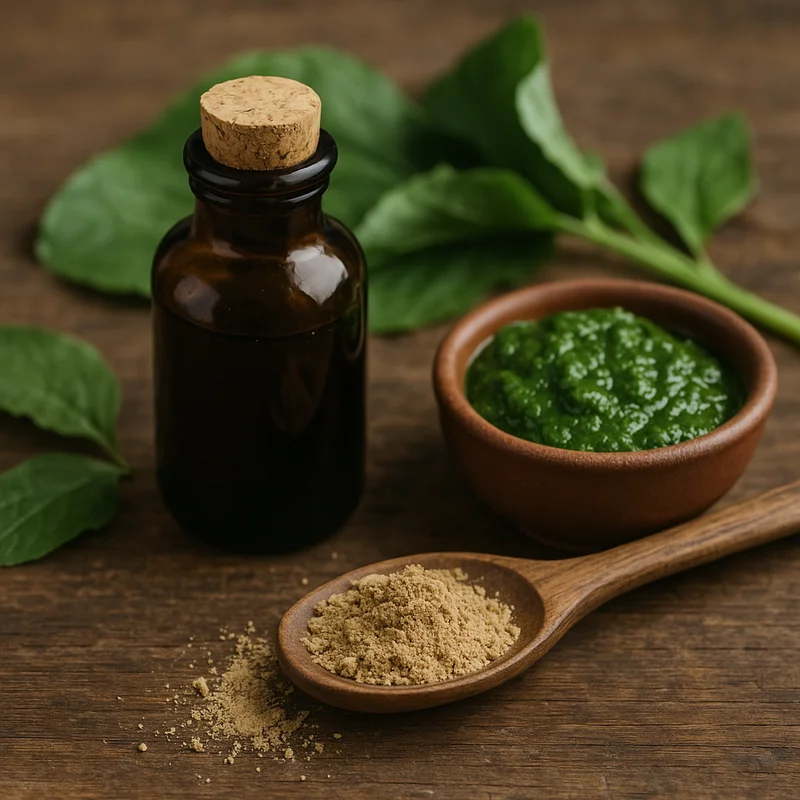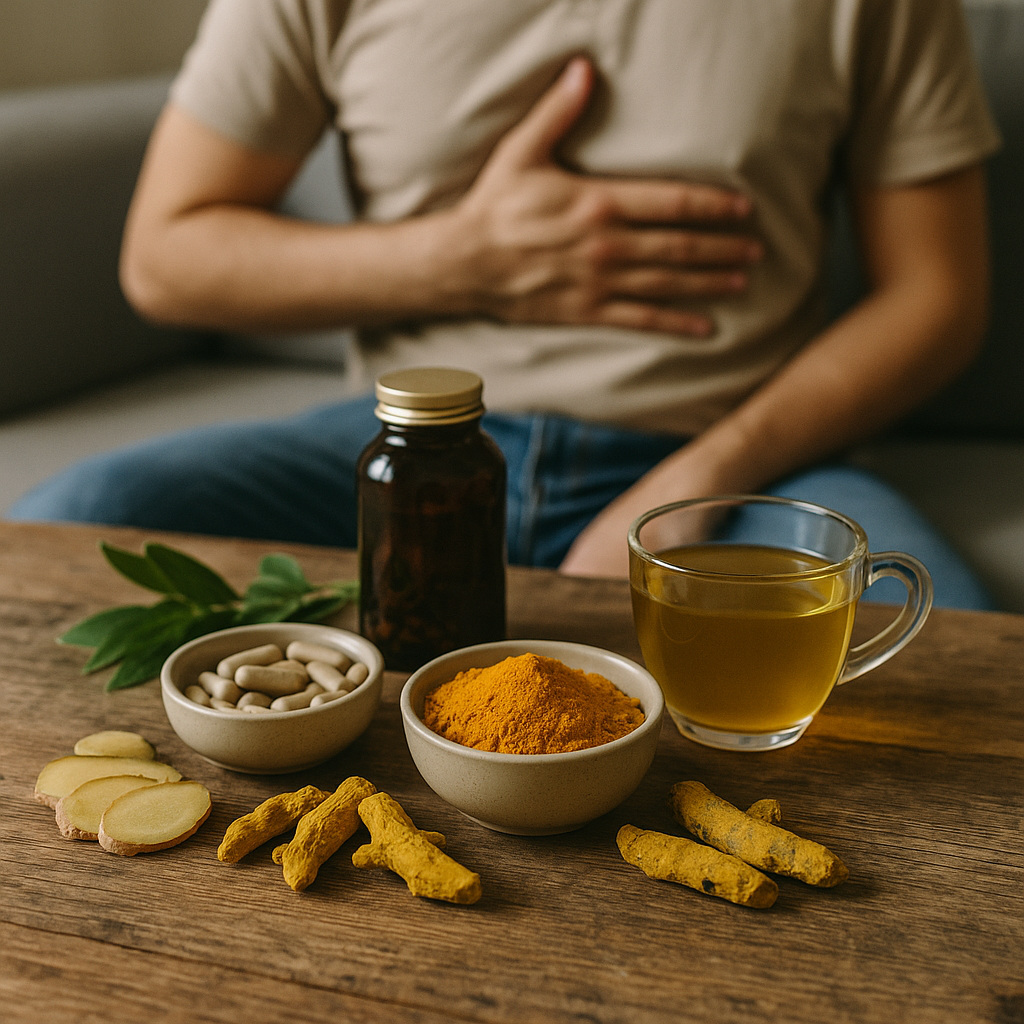Shop Now in Our Store
Ayurvedic Medicine for Gastritis: What Actually Works (And What Doesn’t)

Introduction
Let me tell you something that might sound a little odd: I didn’t even know the word gastritis until I had it.
One day, I’m sipping my second coffee on an empty stomach (bad idea, by the way), and the next, I’m curled up in bed, feeling like my insides are staging a protest. Burning, bloating, that weird nausea that doesn’t quite become vomiting—it was all there. And like so many people these days, I went down a Google rabbit hole. Acid reflux? Ulcer? Stress? Wrong diet? Turns out, it was gastritis—basically, inflammation of the stomach lining. But here's the kicker: modern medicine gave me quick relief but not much else. No long-term answers. No sustainable plan.
That's when I stumbled—skeptically—into Ayurveda.
Now, before you roll your eyes (or light an incense stick), hear me out. Ayurvedic medicine for gastritis isn’t about just chewing on herbs or drinking bitter teas (although there is a lot of that too). It’s a holistic system that looks at why your stomach is inflamed, not just how to suppress it. And unlike the band-aid approach of popping antacids, this stuff goes deeper—into your prakriti (your Ayurvedic constitution), your mental stress, your eating habits, even your freaking sleep patterns.
Why is it relevant? Because gastritis is turning into this silent epidemic. Think about how many people you know who complain about bloating, indigestion, nausea, or acid burps. It’s become so common that many of us think it’s normal. But it’s not. Chronic gastritis can lead to ulcers, vitamin deficiencies, and even increase your cancer risk if you ignore it long enough.
That’s where Ayurveda gets interesting. It doesn’t treat the stomach in isolation. It sees digestion as the center of health (agni, anyone?), and when your agni (digestive fire) is out of whack, everything else tends to follow suit.
In this guide, I’m going to walk you through the Ayurvedic approach to treating gastritis—not just the “what,” but the “why,” the “how,” and the “is this even real?” skepticism that many people (myself included) go through.
Grab a warm glass of cumin-coriander-fennel tea (or just plain water—hydration matters), and let’s start digging in.

What is Ayurvedic Medicine for Gastritis?
Gastritis is a fancy, medical-sounding term for something many of us deal with more often than we admit: an irritated stomach. But in Ayurveda, this isn’t just about excess acid. It's about imbalanced doshas, particularly Pitta—the fire element—and impaired digestive strength, or agni.
Sounds poetic, but also… vague, right?
Let’s get more concrete.
Definition and Origin of Ayurvedic Medicine for Gastritis
In Western terms, gastritis is inflammation of the gastric mucosa. In Ayurvedic terms, this usually corresponds to a Pitta disorder—too much heat, acid, or “fire” in the body. Ayurveda doesn’t have a one-to-one word for "gastritis," but it describes conditions like Amlapitta (literally, “sour Pitta”), which fits the picture almost perfectly: sour belching, burning sensation, acidity, and indigestion.
Ayurvedic medicine for gastritis is not a single herb or pill—it’s an approach. It involves herbs, diet, lifestyle modifications, and sometimes even detox procedures like Virechana (therapeutic purgation) to reset the digestive system.
This approach dates back thousands of years to classical texts like the Charaka Samhita and Sushruta Samhita, where digestion was already considered the bedrock of health. In fact, if you told an ancient Vaidya (Ayurvedic doctor) that you had acid reflux, they wouldn’t reach for a pill—they’d probably ask what you ate for lunch, how angry you've been lately, and whether you’ve been skipping sleep.
Historical Use of Ayurvedic Medicine for Gastritis
Long before the term gastritis existed, Ayurvedic practitioners were addressing the very symptoms we now associate with it. Think about it: ancient India didn’t have processed foods, coffee, or energy drinks, yet digestion issues were still prevalent.
Why? Because Ayurveda says digestion is affected by more than just food. Emotions, seasons, even the time of day plays a role.
Texts from 2000+ years ago talk about herbal combinations for controlling “excess heat in the stomach” or improving “weak digestive fire.” Many of these are still used today—Triphala, Avipattikar Churna, Shatavari, and Licorice (Yashtimadhu) are all classics in gastritis management.
One interesting bit? The concept of Satmya—individual compatibility. Something as simple as milk can be healing for one person and harmful for another. That kind of personalization is way ahead of modern medicine, if you ask me.
Cultivation and Harvesting Details (Where Applicable)
Ayurvedic herbs used for gastritis often come from carefully nurtured plants—not mass-farmed crops doused in chemicals. Take Shatavari, for example. It’s a root herb grown in humid forests and harvested once its thick, tentacle-like roots mature after 12–18 months. Or Amla (Indian gooseberry)—a powerhouse ingredient in formulations like Triphala and Avipattikar—it’s plucked in winter when the fruit is most potent.
Licorice, another big one for soothing the gut lining, is harvested after 3–4 years of root growth to ensure it’s rich in glycyrrhizin—the active component known for reducing inflammation.
But beyond the botany, there’s this reverence in the way Ayurveda approaches plants. Many traditional practitioners will offer prayers before harvesting. Not saying you need to believe in that, but I kinda like the humility in it.
Key Components and Active Substances in Ayurvedic Medicine for Gastritis
Now let’s get a little nerdy.
You’ve probably seen Ayurvedic labels like “cooling,” “soothing,” or “Pitta-pacifying” on herbal supplements. But what’s actually in them? What’s doing the work?
If you look under the hood of Ayurvedic medicine for gastritis, you’ll find a complex blend of herbs, minerals, and sometimes even metals (yes, you heard that right—bhasmas, when properly processed, are a thing in classical Ayurveda). But most commonly, the heavy-lifters are plants that are rich in anti-inflammatory, mucosa-protective, and acid-balancing compounds.
Chemical Composition and Active Ingredients
Let’s break down a few of the key players:
-
Licorice (Yashtimadhu): Contains glycyrrhizin, a compound shown to promote mucus secretion in the stomach lining and reduce inflammation. It’s like a natural protective coat for your gut wall.
-
Amla (Indian Gooseberry): Bursting with Vitamin C, but more importantly, it balances acid levels and supports liver function. It’s both a rasayana (rejuvenator) and a digestive.
-
Shatavari: Rich in saponins and phytoestrogens, it cools the gut and supports tissue repair. Often used in ulcers and gastritis.
-
Triphala: Technically three fruits (Amla, Haritaki, Bibhitaki) — works gently to detox, improve motility, and support microbiome balance.
-
Avipattikar Churna: A classic Pitta-balancing formula that contains rock sugar, cardamom, and other digestive herbs. It’s basically an herbal antacid.
We’re not just talking about vague “plant energy” here. There’s real biochemical action happening—enzymes, antioxidants, tannins, flavonoids.
How the Components Affect the Body
Here’s what’s cool (and a bit mind-blowing): Ayurvedic medicine doesn’t just suppress symptoms. These herbs actually help rebuild and repair.
-
Licorice helps regenerate the gastric mucosa.
-
Amla lowers oxidative stress in the gut lining.
-
Triphala supports the natural movement of food without causing dependence, unlike laxatives.
-
Guduchi, often used alongside gastritis remedies, is an adaptogen. It boosts immune tolerance, so if your gastritis has an autoimmune angle (like atrophic gastritis), this can be huge.
Many of these herbs also modulate gut flora, which is something modern medicine is just beginning to appreciate. There’s this synergy in Ayurvedic combinations—something more than the sum of their parts.
Comparison with Similar Ayurvedic Remedies
Not all gut-soothing Ayurvedic remedies are made equal.
-
Avipattikar vs. Hingvastak: Both aid digestion, but Avipattikar cools; Hingvastak heats. The first is great for acid reflux and heat-based gastritis. The second? Better for gas and cold digestion.
-
Shatavari vs. Ashwagandha: Shatavari is cooling and mucosa-soothing. Ashwagandha is warming and adaptogenic. In gastritis, Shatavari wins.
-
Triphala vs. Isabgol (Psyllium husk): Triphala detoxes gently over time; Isabgol is more mechanical, bulking and clearing. The first works with your system, the latter pushes things out.
So yeah, context really matters. You don’t just pick something because it says “good for digestion.” You match it to your dosha, symptoms, and even the season.

Health Benefits and Therapeutic Uses of Ayurvedic Medicine for Gastritis
This is where things get practical. The question most people ask is:
“Okay, but does it actually help?”
Short answer: Yes — if you’re using the right herbs in the right way, at the right time, and (this part is underrated) in the right mindset. Let’s dig into the specifics.
Physical Health Benefits
-
Reduces burning and acidity: Herbs like Amla and Licorice soothe the lining of the stomach and reduce acid production without blocking it completely like PPIs (proton pump inhibitors) do.
-
Improves digestion over time: Instead of just putting out fires, Ayurvedic medicine strengthens your agni — so you digest food better, absorb nutrients, and reduce flare-ups.
-
Heals ulcers and erosions: Shatavari, Licorice, and Ghee are known for their tissue-healing abilities. They literally rebuild what the acid has broken down.
-
Reduces nausea and bloating: Some of the formulations (Avipattikar Churna, Triphala) improve gut motility and reduce the fermentation process that causes gas.
Oh—and don’t underestimate the relief of not living in constant digestive discomfort. That’s healing, too.
Mental and Emotional Health Benefits
This might sound a bit out there, but if you’ve ever had gastritis, you know it affects your mood. Ayurveda gets that.
-
Licorice and Amla have mild adaptogenic effects.
-
Triphala, by supporting gut-brain axis balance, helps reduce fogginess and mental fatigue.
-
Balancing Pitta is not just physical—emotionally, it’s about reducing irritability, anger, and perfectionism.
So yeah, calming your gut can calm your mind. And vice versa.
Most Effective Use Cases
-
Chronic gastritis with acid reflux: Pitta-pacifying diet + Avipattikar Churna + Shatavari.
-
Stress-induced gastritis: Brahmi + Licorice + Ashwagandha (careful here — only if Vata isn't too high).
-
Ulcerative symptoms: Shatavari + A2 cow ghee + Yashtimadhu (sometimes in decoction form).
-
Post-antibiotic gut issues: Triphala + Guduchi + light fasting.
But honestly? No two cases are the same. You need customization.
Use of Ayurvedic Medicine in Integrated Therapy
The sweet spot? Ayurveda + Modern Diagnostics.
I know purists hate this, but I’ve seen the best outcomes when people use Ayurvedic protocols alongside modern testing (endoscopy, H. pylori check, vitamin B12 levels). One informs the other.
Some clinics even integrate both in treatment—offering natural remedies while tracking progress with labs.
It's not about choosing sides. It’s about what actually works.
Indications and Contraindications of Ayurvedic Medicine for Gastritis
Okay, before you run off to the herb shop, let’s talk about when to use Ayurvedic medicine—and when not to.
Health Conditions Where It’s Recommended
-
Hyperacidity
-
Reflux esophagitis (GERD)
-
Stress-induced gastritis
-
Drug-induced gastritis (NSAIDs, for example)
-
H. pylori positive gastritis (as supportive care)
Ayurveda is often the first line for mild cases and a parallel therapy in moderate to chronic ones.
Possible Side Effects and Contraindications
Here’s the truth: natural doesn’t mean harmless.
-
Licorice can raise blood pressure if taken in excess or over long periods.
-
Triphala might cause loose motions if your digestion is already weak.
-
Avipattikar contains rock salt—be cautious with kidney patients or those on sodium restrictions.
-
Heavy metals (in bhasmas), if not from a trusted source, can be toxic.
Always—and I mean always—consult a qualified practitioner. Especially if you're on allopathic meds.
Restrictions Based on Age, Health Status, or Drug Interactions
-
Children and elderly: Stick to milder formulations like Amla juice, or Ghee-based preparations.
-
Pregnant women: Avoid herbs like Triphala or Ashwagandha unless supervised.
-
Drug interactions: Licorice interacts with corticosteroids and some antihypertensives. Be careful.
And no—just Googling “is it safe” isn’t enough. Ayurveda is subtle. Personalization matters.

How to Properly Use Ayurvedic Medicine for Gastritis
Let’s get into the how. Because popping random pills doesn’t work—not even herbal ones.
Recommended Forms and Dosages
-
Avipattikar Churna: 1/2 to 1 tsp with warm water after meals.
-
Licorice Powder (Yashtimadhu): 1/4 to 1/2 tsp with ghee or honey before meals.
-
Shatavari Capsules: 500mg once or twice daily, or root powder with milk at bedtime.
-
Amla Juice: 10–20 ml on an empty stomach in the morning.
Note: Fresh, organic, and small-batch products tend to be more effective. Quality really matters here.
Best Time to Take It / Dosage Schedule
-
Before meals: To soothe the lining (Licorice, Ghee).
-
After meals: To improve digestion and reduce acid (Avipattikar).
-
At night: To promote healing during rest (Shatavari + warm milk = magic).
Most regimens go for 4–6 weeks minimum. Sometimes longer, depending on severity.
Recipes and Practical Advice
Here’s a quick gut-healing tea I swear by:
Coriander-Cumin-Fennel Tea (aka CCF Tea):
-
1 tsp each of cumin, coriander, fennel seeds
-
Boil in 2 cups water for 5–7 min
-
Sip warm throughout the day
Or try this bedtime remedy:
Shatavari-Ghee Milk
-
1/2 tsp Shatavari
-
1 cup warm A2 cow milk
-
1/4 tsp ghee
-
Optional: pinch of cardamom
Calms, cools, nourishes. Feels like a hug from the inside.
Success Stories and Real-Life Examples (Case Studies)
I’ll be honest: it’s one thing to read about herbs and doshas, but quite another to hear about someone actually getting better. So here are two real-life stories that stayed with me.
Case Study 1: Ramesh, 42 – The Corporate Burnout
Ramesh was the typical overachiever. Long hours, zero exercise, three coffees before noon, and a spicy street food addiction. Then came the symptoms: burning in the chest, belching, and that gnawing ache in his stomach every evening. An endoscopy revealed moderate gastritis. His doctor prescribed PPIs. Relief came… but only while he was on them. Once stopped, the symptoms stormed back.
On a friend’s recommendation, he visited an Ayurvedic clinic. The doctor didn’t just hand him pills. Instead, they did a full prakriti analysis and started a program: Triphala at night, Amla juice every morning, and Shatavari with milk at bedtime. Plus, a big shift in diet—warm, mildly spiced foods and no more late-night eating.
Within six weeks, he was off PPIs, sleeping better, and the bloating was gone. He still avoids coffee and says he’s learned to “eat like a human, not a machine.”
Case Study 2: Neha, 29 – Anxiety and Acidity
Neha’s gastritis was different. No junk food, no coffee addiction. But she was anxious all the time. Her belly burned even when she hadn't eaten anything spicy. Antacids helped for a few hours but didn’t solve much.
Ayurveda identified the root cause as a Vata-Pitta imbalance, worsened by overthinking and irregular meals. Her regimen? Licorice powder with ghee, Brahmi for anxiety, and a digestive tea made from coriander and fennel.
Three months in, not only did her gastritis subside, but she also said she “stopped feeling like her stomach was in a constant panic.” Sometimes, it’s the mind that needs calming first.
Scientific Research and Evidence of Effectiveness of Ayurvedic Medicine for Gastritis
Yes, I know some folks won’t believe a thing until they see the “science.” Fair enough. Ayurveda might be thousands of years old, but modern research is starting to catch up.
Summary of Clinical Studies
-
A study published in the Journal of Ethnopharmacology (2020) found that Licorice extract significantly reduced gastric inflammation and improved healing in NSAID-induced gastritis.
-
Another study in the Indian Journal of Traditional Knowledge tested Avipattikar Churna on 50 gastritis patients. Results showed a statistically significant reduction in symptoms like hyperacidity, nausea, and belching within 4 weeks.
-
Amla (Emblica officinalis) has been shown to possess antioxidant and cytoprotective properties, making it useful in managing mucosal damage caused by excessive acid.
That said, more large-scale, double-blind trials are needed. But anecdotal evidence + small trials + 2000 years of practice? That’s not nothing.
Comparison with Results from Conventional Medicine
Let’s be real: modern antacids and PPIs offer fast relief. But they’re not long-term solutions.
-
PPIs can cause rebound acidity and mess with mineral absorption (ever heard of PPI-induced B12 deficiency? It’s a thing).
-
Antacids work temporarily but don’t address inflammation.
Ayurveda? Slower, yes. But more sustainable. And way fewer side effects.
In an ideal world, we’d use the best of both. Acute flare-up? Use a PPI short-term. But to fix the terrain? That’s Ayurveda’s game.
Conclusion
So—does Ayurvedic medicine for gastritis actually work?
If you were hoping for a simple yes or no, sorry to disappoint. The real answer is more nuanced. Yes, it works—but only if you work with it. You need the right herbs, the right practitioner, and (most importantly) a willingness to change the habits that got you into this mess.
What I love about Ayurveda is that it treats you like a whole person—not just a stomach on fire. It recognizes that your digestion isn’t just physical. It’s emotional, mental, seasonal, even spiritual.
And that’s why it works when other things don’t.
👉 Get personalized advice about Ayurvedic medicine for gastritis at Ask-Ayurveda.com. Because no two stomachs—and no two stories—are the same.
Frequently Asked Questions (FAQ)
1. Can I take Ayurvedic medicine for gastritis along with my regular antacids or PPIs?
Yes, in many cases you can. But it’s always best to consult an Ayurvedic doctor first. Some herbs, like Licorice, can interact with medications or affect potassium levels if taken long-term.
2. How long does it take for Ayurvedic treatment to show results for gastritis?
You might feel better within a week or two, but real healing usually takes 4–12 weeks. Remember, Ayurveda is about fixing the root—not just patching symptoms.
3. Is Triphala good for gastritis?
Surprisingly, yes! Even though it’s often used as a detox, Triphala can support the gut microbiome and reduce inflammation. But if you have very sensitive digestion, start slow or use under supervision.
4. Are there any foods I should avoid while using Ayurvedic medicine for gastritis?
Yes—anything spicy, oily, acidic (like tomatoes, vinegar), fermented, or overly processed. Avoid skipping meals and cold drinks too. Stick to warm, mildly spiced, easy-to-digest food.
5. Can children or elderly people use Ayurvedic medicine for gastritis?
Absolutely, but with adjusted dosages. Stick to gentler options like Amla, Ghee, and CCF tea. Avoid strong laxatives or intense detox unless prescribed.
This article is checked by the current qualified Dr Sujal Patil and can be considered a reliable source of information for users of the site.
Got any more questions?
Ask Ayurvedic doctor a question and get a consultation online on the problem of your concern in a free or paid mode.
More than 2,000 experienced doctors work and wait for your questions on our site and help users to solve their health problems every day.

